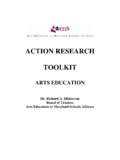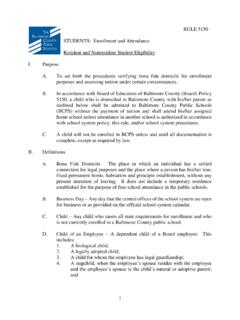Transcription of Better Practice in Music Education - AEMS
1 Marie McCarthy, PhDUniversity of MarylandRegina Carlow, MMMontgomery county public SchoolsKathleen Gabriele, MEdAnne Arundel county public SchoolsMargo Hall, MSFrederick county public SchoolsJudy Moore, MMPrince George s county public SchoolsRobert Woody, PhDUniversity of MarylandJames L. Tucker, Jr. Series EditorBETTER Practice IN ARTS EDUCATIONVOLUME IIMUSICEDUCATIONBETTER Practice inBUILDING EFFECTIVE TEACHING THROUGH EDUCATIONAL RESEARCHM usic 6/17/08 12:10 PM Page 1 Better Practice IN Music EDUCATIONB etter Practice in Arts Education , Volume IIBuilding Effective Teaching Through Educational ResearchJames L. Tucker, Jr. Series EditorCopyright 2003 by the Maryland State Department of Education . All rights reserved. Published in State Department of Education200 West Baltimore StreetBaltimore, MD 21201-2595 Telephone: (410) 767-0352 or (410) 767-0100 Fax: (410) 333-1146 TTY/TDD: 410-333-6442 Web site: Carlow, MMMontgomery county public SchoolsKathleen Gabriele, MEdAnne Arundel county public SchoolsMargo Hall, MSFrederick county public SchoolsJudy Moore, MMPrince George s county public SchoolsRobert Woody, PhDUniversity of MarylandJames L.
2 Tucker, Jr. Series EditorMarie McCarthy, PhDUniversity of MarylandBETTER Practice IN ARTS EDUCATIONVOLUME IIMUSICEDUCATIONBETTER Practice inMARYLAND STATE DEPARTMENT OF EDUCATIONBUILDING EFFECTIVE TEACHING THROUGH EDUCATIONAL RESEARCHBETTER Music EDUCATIONiiMaryland State Board of EducationEdward L. Root, PresidentDunbar Brooks, Vice PresidentNancy S. Grasmick, Secretary/TreasurerLelia T. AllenJ. Henry ButtaBeverly A. CooperCalvin D. DisneyCharlene M. DukesRichard L. GoodallKarabelle PizzigatiMaria C. Torres-QueralDavid F. Tufaro Brian W. Frazee, Student MemberMaryland State Department of EducationNancy S. Grasmick, State Superintendent of SchoolsRonald A. Peiffer, Deputy State SuperintendentOffice of Academic PolicyA. Skipp Sanders, Deputy State SuperintendentOffice of AdministrationJoAnne L.
3 Carter, Deputy State SuperintendentOffice of Instruction and Academic AccelerationColleen Seremet, Assistant State SuperintendentDivision of InstructionDixie Stack, Director of CurriculumDivision of InstructionJames L. Tucker, Jr., Coordinator of Fine ArtsDivision of InstructionState of MarylandMartin O Malley, GovernorThe Maryland State Department of Education does not dis-criminate on the basis of race, color, sex, age, national origin,religion, disability, or sexual orientation in matters affectingemployment or in providing access to programs. Forinquiries related to departmental policies, contact the EquityAssurance and Compliance Music EDUCATIONFOREWORDThe State of Maryland is gaining increased recognition nationally for its educationreform initiatives and its commitment to high standards of accountability in educa-tion.
4 It further recognizes the need for high quality arts Education as an essential partof our children s Education . In 1989, after a decade of requiring experiences indance, Music , theatre, and the visual arts for all students in grades K-8, Marylandbecame one of the first states to require that students earn a credit in the fine arts toreceive the Maryland High school Diploma. Maryland s reform initiatives have tra-ditionally focused on envisioning what students should know and be able to do, pro-viding resources and enhancing instructional Practice , and documenting studentlearning. This particular project focuses on informing instructional 1995, the Maryland State Board of Education adopted a goal that 100 percent ofMaryland s students will participate in fine arts programs that enable them to meetthe content and achievement standards established by State standards for the arts.
5 By1997, K-12 standards for dance, Music , theatre, and visual arts Education , developedby a 38 member task force, were approved by the State Board. The following yearProject Better was initiated to develop a resource tool that would inform instruc-tional Practice in each of the art concept for Project Better Building Effective Teaching Through EducationalResearch was created by the Division of Instruction of the Maryland StateDepartment of Education (MSDE) during the late 1980s as part of its mission to pro-mote effective instruction. The development of the four volume publication for thecurrent project was guided by the same three major objectives: 1) to identify currentresearch on effective instruction, 2) to synthesize this research in the form of non-the-oretical summaries, and 3) to deliver this information directly to information in this publication is designed as a resource to assist teachers inexpanding and refining their repertoire of teaching strategies and to guide instruc-tional planning and decision-making that supports student achievement of Statestandards in the arts.
6 It is not intended to prescribe a particular style of teaching orone best method. This resource provides a guide to teachers as they consider theircurriculum objectives, the nature and needs of their students, their personal style ofteaching, and their available instructional resources. The application of this knowl-edge will result in more effective teaching and more powerful Music EDUCATIONivINTRODUCTIONThe first edition of Better Practice in Music Education was written by AnitaHaushild-Cooper for the Maryland State Department of Education and published in1991. The present edition was commissioned in 1998 with the goal of supporting theMaryland Essential Learner Outcomes in Music . A team of Music educators at theUniversity of Maryland, College Park Regina Carlow, Kathleen Gabriele, Margo Hall,Judy Moore, and Robert Woody prepared the text, and Marie McCarthy coordinatedtheir efforts.
7 This considerably restructured edition includes research studies that addressthe Essential Learner Outcomes. In cases of repeated topics, the authors revised andupdated each entry to reflect research findings published since the first edition was com-piled. For example, the topic of problem solving now falls in the context of developingcritical thinking skills; the expanded definition of minority students includes research onethnicity and ESOL students; and visual aids and manipulative materials are presented asmultisensory the intervening period between the publication of the first edition and the present one,we have witnessed significant developments in Music Education research. Of central impor-tance is the publication of the Handbook of Research on Music Teaching and Learning(1992),followed by the New Handbook of Research on Music Teaching and Learning(2002), both ofwhich synthesize research findings pertaining to a comprehensive range of Music educationtopics.
8 New research journals in Music Education provide additional forums for publishingfindings; for example, the Philosophy of Music Education Review,the Quarterly Journal ofMusic Teaching and Learning,and Research Studies in Music MENC:National Association for Music Education publication Updatefulfills a unique function inapplying research findings to classroom Practice . In general, research methodology expanded to embrace various forms of qualitativeresearch, exploring best practices in Music Education in innovative ways and alsoencouraging teachers to carry out practitioner research in their own classrooms. Evenin light of all the positive developments in Music Education research in the past decade,the gap between research and Practice presents an ongoing challenge.
9 Sources such asvBETTER Music EDUCATIONI ntroductionBETTER Music EDUCATIONviINTRODUCTIONBETTER Practice in Music Education seek to bridge that gap by identifying the impli-cations of research findings for classroom instruction. The vast research literature base we had to draw upon required us to make choices andnarrow the literature search. For example, we chose literature published after 1990. The25 topics selected for the first edition were consolidated into two broad categories: learn-ers and the learning environment, and teacher effectiveness. The first of these coversresearch findings that offer insight into aspects of instruction such as classroom manage-ment, use of media, learning styles, and gender issues. The second category focuses onteacher attitude, knowledge, and competence, in addition to a broad range of instruc-tional strategies, from modeling to critical thinking, motivational feedback to verbalinstruction.
10 Our third area is intended to support the learner outcomes described in the MarylandEssential Learner Outcomes in Music . The Maryland Fine Arts Standards, which arealigned with the National Standards for Arts Education and were created with the par-ticipation of over 2,000 Maryland teachers, are a set of documents entitled MarylandEssential Learner Outcomes for the Fine Arts (dance, Music , theatre, and visual arts) forelementary, middle, and high school . They describe what children should know and beable to do in the arts by fifth grade, eighth grade, and 12th grade. We have chosen tohighlight research on best Practice in the four outcome areas in the following ways: Wesynthesized research in the area of singing and playing instruments to support Outcome1 involving students perceiving, performing, and responding to Music .






